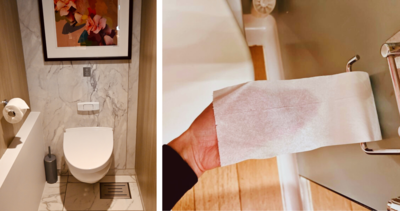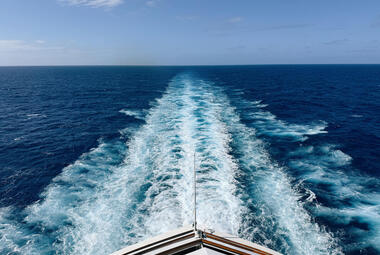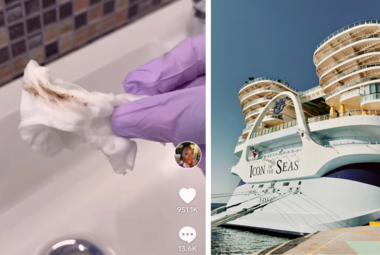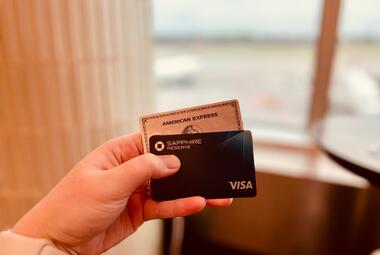There is so much to love about cruising, from the delicious food to fabulous entertainment, thrilling attractions, and exciting itineraries. Cruise vacations are meant to be all about relaxing, letting loose, and enjoying the ocean views.
However, not everything on a cruise ship could be described as glamorous. While everyone has their favorite aspect, there is one thing that we all collectively hate about cruising…the toilet paper! If you’ve ever vacationed on a cruise ship, you know exactly what I am talking about. Anyone who has cruised can agree that the toilet paper situation while cruising is less than ideal.
The toilet paper on a cruise ship might as well be replaced with sandpaper. The thin-as-can-be toilet paper found in bathrooms is far from plush or luxurious. Some might even say that cruise ship toilet paper is a sad excuse for single-ply tissue and resembles half-ply toilet paper.
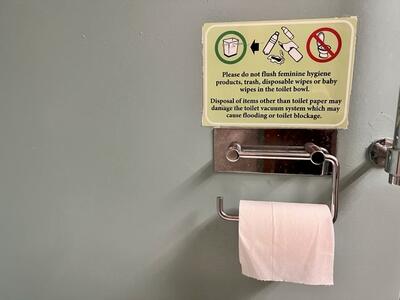
Last year, I was cruising with my grandparents when my grandpa said, “This toilet paper is so thin, I could hold it up in front of my watch and still see the time." It was that thin!
Regardless of which cruise line you sail with, the humbling situation of thin toilet paper will likely be part of your cruising experience. It really does not matter whether you cruise on a luxurious, boutique ship or one of the mega-ships from a mainstream cruise line.
Either way, disdain towards the cruise ship’s sad excuse for toilet paper can quickly become an integral aspect of your daily cruise experience. If you’re a first-time cruiser, you might be particularly surprised by your subpar bathroom experience.
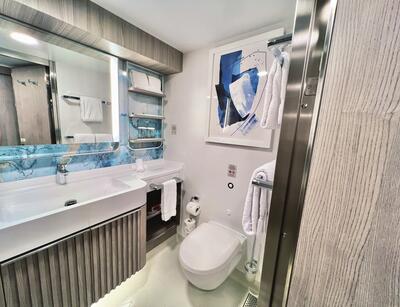
You might be wondering if the toilet paper on your cruise is really as bad as you’re imagining. The answer is yes, the toilet paper situation really is one of the worst parts of cruising.
However, there are good reasons cruise ships have such scratchy, thin toilet paper onboard. And no, you really shouldn't bring your own toilet paper.
Here is everything you could want to know about cruise ship toilet paper, including important reasons why cruise ships use horrible quality toilet paper. Let this article also serve as emotional support for anyone personally victimized by their cruise ship toilet paper.
Why is cruise ship toilet paper so bad?
The allure of cruising is being able to visit multiple destinations on an itinerary without having to pack and unpack your bags. Cruise ships are different from land-based hotels and resorts for many obvious reasons, but the biggest one is that cruises operate in the ocean.
It’s easy to forget that your ship is not actually a floating city. Rather, cruise ships are massive boating vessels that operate in a marine ecosystem. Because of this, cruise ships have different operational needs than a typical hotel ashore.

With an intricate plumbing and sewage system, cruise ships must use toilet paper that can dissolve quickly and easily. Marine evacuation systems, which help process onboard sewage, are unable to process the plushy, double-ply toilet paper you might use at home.
Additionally, cruise ships continue focusing on sustainability by minimizing their impact on the ocean. For this reason, cruise ships use marine-grade toilet paper, which is likely more environmentally friendly and biodegradable.
Cruise ships are easily susceptible to clogged toilets
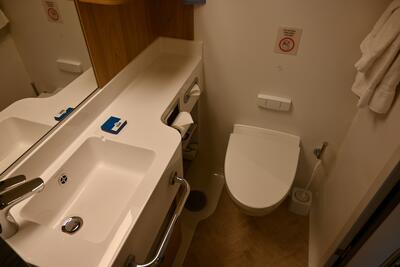
Considering the size of cruise ships, the sewage pipes onboard are smaller, making them more susceptible to blockage. Clogs and blockages can happen for many different reasons, but the most common reason comes from guests flushing forbidden objects down their toilet.
Modern cruise ship cabins use vacuum flush toilets. These kinds of toilets utilize vacuum technology, which uses air to drive waste from the toilet and propel the waste into the sewage system. This minimizes the amount of water used with each flush, as the toilet water is actually fresh water. Saltwater can cause salt build-up and blockage in the sewage system, which is problematic.
The sewage systems are temperamental, so it’s prudent that cruise ship passengers only flush the toilet paper provided by the cruise line. Flushing any other hygiene products, especially feminine products, can cause major plumbing issues on cruise ships.
For this reason, cruise ships require guests to use the dreaded sandpaper toilet paper onboard. You will also read many warnings about flushing only the provided toilet paper in your stateroom and public bathrooms.
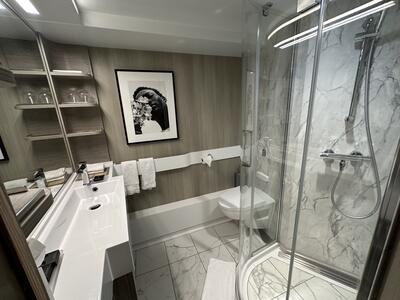
When the pipes get clogged, the culprit toilet is not the only one impacted. Unfortunately, multiple cabins will be impacted when the pipes have a clogging issue. Under these circumstances, the ship’s marine engineer or plumber has to unclog the pipes by manually removing the blockage.
In a social media post, Carnival Cruise Line’s brand ambassador, John Heald, described the importance of following the rules in your cabin bathroom regarding toilet paper.
“Our plumbers hate wet wipes because, despite the signs that plead with you not to flush [wet wipes] down the suction toilet system, they still do. And this results in [our plumbers] having to put on the long glove and shoving [their] arm up a pipe full of the devil's dumplings so that the toilets in that cabin section will start flushing again,” shared Heald.
Can you bring your own toilet paper on a cruise?
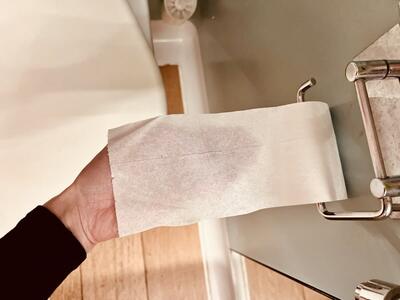
With the terrible quality toilet paper on a cruise ship, you might be wondering whether you can - or should - bring your own toilet paper or wipes onboard. It seems as though supplying your personal toilet paper could be a harmless idea to elevate your cruise bathroom experience.
In short, bringing your own toilet paper on a cruise ship is not a good idea. Due to the sensitivity of the plumbing on a cruise ship, this is not recommended and is highly discouraged. Some cruisers even report that their personal rolls of toilet paper were confiscated while boarding their cruise ship.
However, as long as you do not flush your own toilet paper or wipes down the toilet, cruise lines do not explicitly ban toilet paper from being brought onboard.
If you are desperate to use an alternative to the cruise ship toilet paper, you’ll need to dispose of your own toilet paper or wipes in the trash. Some cruisers have suggested bringing doggie poop bags to place used wipes or toilet paper, which can then be disposed of.
Where does your poop go on a cruise ship?
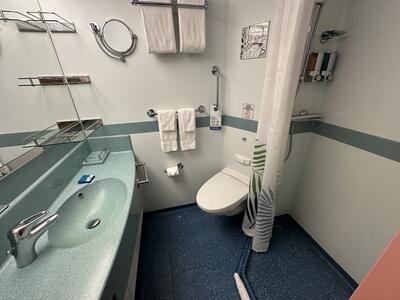
While we are on the subject, you might be curious about how the sewage system works on a cruise ship.
Eating is one of the best parts of a cruise - and what goes in, must come out. The unpleasant topic of waste management and bowel movements is certainly not the most exciting aspect of cruising, but it is interesting and important, nonetheless.
As mentioned, the sewage system is vastly different aboard a cruise ship than a land-based building operation. Cruise ships have their own waste management system, which is quite complicated and sophisticated. Cruise lines are actually very regulated and work closely with government agencies that specialize in environmental concerns. With this working relationship, cruise lines can ensure practices are approved and sustainable for the marine environment.
Your poop, along with other wastewater, goes through a water-treatment system onboard. The wastewater is collected and treated appropriately. Nothing goes overboard until the wastewater has been properly treated through the ship’s onboard facility.
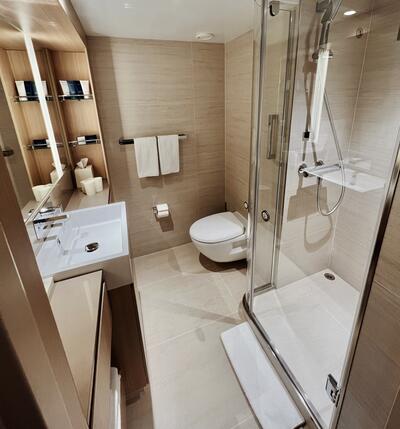
A cruise ship’s wastewater is processed through a wastewater purification plant, which is located onboard. The water is split into three different categories: grey water, black water, and bilge water. The grey water is collected from drain, laundry, and sink, while the black water comes from food waste (galleys) and toilets. Finally, bilge water is the oil released from the engine compartments.
Since human waste would be considered black water, we will follow this process. There are three main steps in the process, including aeration, filtration, and disinfection.
The black water first enters an integrated treatment system where bacteria is added to an aeration chamber. Through this process, the bacteria helps to break down the organic contaminants that are dissolved in the wastewater.

The next phase is a membrane filtration system where the waste will go through more filtering for impurities. This is where the wastewater enters into a settlement chamber, which allows the water to float to the top and denser substances sink to the bottom. After this process, any semi-solid material returns for more filtration and is reprocessed.
In the last phase of the process, the water is disinfected with UV radiation. This allows for the sterilization of any remaining pathogens. At the end of the process is clean water that is bacteria-free and safe to use. The water is considered to be almost the same quality as tap water.
Now, the cruise ship has created its own water that can used onboard. Additionally, the water could be released into the ocean while the ship is sailing at sea. Under international maritime regulation, the cruise ship can only release this filtered water once it has reached a minimum threshold from land. This helps protect the local marine life. Also, some areas do not allow for the release of water and prohibit the practice.


